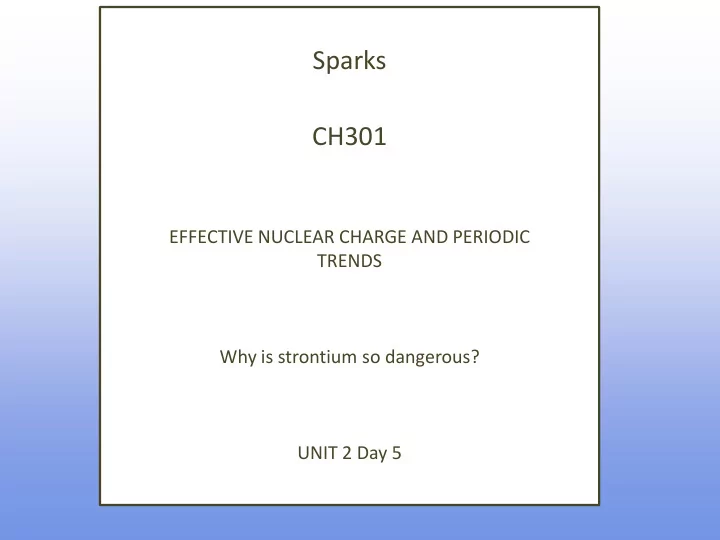

Sparks CH301 EFFECTIVE NUCLEAR CHARGE AND PERIODIC TRENDS Why is strontium so dangerous? UNIT 2 Day 5
QUIZ QUESTION: INDIVIDUAL WORK, NO TALKING How many electrons in Na have l =0?
What are we going to learn today? − Effective Nuclear Charge and Periodic Trends • Determine trends in effective nuclear charge in the periodic table • Relate effective nuclear charge to atomic radii, ionic radii, and ionization energy
POLLING QUESTION Do all electrons in an atom feel the same attraction to the nucleus? A. Yes B. No – the ones in lower energy levels feel a stronger attraction to the nucleus. C. No – the ones in higher energy levels feel a stronger attraction to the nucleus.
EXAMPLE OF EFFECTIVE NUCLEAR CHARGE • Consider Li: 1s 2 2s 1 . • The core [He] electrons shields the 2s electron. – It does not ‘feel’ the effect of all 3 protons in the nucleus.
POLLING QUESTION As you move across a row (left to right), what happens to Z eff ? A. It stays the same. B. It gets larger. C. It gets smaller.
Shielding and effective nuclear charge Neon Sodium
POLL: CLICKER QUESTION Shielding and effective nuclear charge Because of shielding Na is more like H than Ne As I go from left to right in a period I add electrons: more shielding and I add more protons: bigger Z Which has a larger effect? A) Adding more electrons across period B) Adding more protons across period
• We can use Z eff to determine trends in: – Atomic radii – Ionic radii – Ionization energy • Class Activity Handout
QUIZ: CLICKER QUESTION • Which would you expect to have the larger atomic radius: Li or K? A. Li B. K C. They would have equal atomic radii.
QUIZ: CLICKER QUESTION • Which would you expect to have the larger atomic radius: C or O? (Consider all you know about the electronic structure of atoms: principle quantum number, effective nuclear charge, etc.) A. C B. O C. They would have equal atomic radii.
Figure 12.38: Atomic radii (in picometers)
Ionic Radius 14
POLL: CLICKER QUESTION Cations are always _______ their respective neutral atoms. Why? A. smaller than B. the same size as C. larger than
Li Li + r = 1.52 A r = 0.90 A Na Na + r = 1.86 A r = 1.16 A
QUIZ: CLICKER QUESTION Anions are always _______ their respective neutral atoms. Why? A. smaller than B. the same size as C. larger than
F - F r = 0.72 A r = 1.19 A Cl - Cl r = 1.00 A r = 1.67 A
QUIZ: CLICKER QUESTION Which would have a larger radius: Na + or Mg 2+ ? A. Na + B. Mg 2+ C. They would have the same radius.
POLL: CLICKER QUESTION • The three ions, N 3- , O 2- , and F - have these three ionic radii (in no particular order): 1.71 A, 1.19 A, and 1.26 A. Which of these three values would be the radius for N 3- ? A. 1.71 A B. 1.19 A C. 1.26 A
QUIZ: CLICKER QUESTION Arrange these elements based on their increasing ionic radii: S, K, Cl A. Cl 1- < S 2- < K + B. K + < Cl 1- < S 2- C. S 2- < Cl 1- < K + D. K + < S 2- < Cl 1-
Ionic Radius
IONIZATION ENERGY
POLL: CLICKER QUESTION Which is always higher: IE 2 or IE 1 . Why? A. IE 2 B. IE 1
QUIZ: CLICKER QUESTION As you move across a period, you would expect IE 1 to __________. Why? A. increase B. decrease
QUIZ: CLICKER QUESTION Thought Question! As you move down a group, you would expect IE 1 to __________. Why? A. increase B. decrease
What have we learned? LIGHT CAN BE USED TO PROBE THE ENERGY OF ELECTRONS IN MATTER ELECTRONS IN ATOMS HAVE DISCRETE ENERGIES ELECTRONS CAN BE DESCRIBED BY WAVE FUNCTIONS THAT CAN BE CLASSIFIED BY QUANTUM NUMBERS THE HYDROGEN WAVEFUNCTIONS CAN APPROXIMATE THE WAVEFUNCTIONS OF MULTIELECTRON ATOMS THE ORDERING OF ENERGY LEVELS IS GENERALLY THE SAME FOR ATOMS FOR ALL ELEMENTS NUCLEAR CHARGE FELT BY VALENCE ELECTRONS IS SHIELDED BY THE CORE ELECTRONS
Learning Outcomes Describe the difference between one electron systems and multi-electron systems. Predict electron configurations based on position on periodic table. Apply the Aufbau principle to determine the configuration for any atom or ion. Use Hund ’ s Rule to determine electron configuration using an orbital diagram (electrons in individual orbitals with spins. Students will use the shell model of multi-electron atoms to describe the concept of core vs. valence electrons Define ionization energy. Describe the concept of electronic shielding and effective nuclear charge (Zeff) and their relationship to trends in ionization energy, atomic radii and ionic radii.
Recommend
More recommend